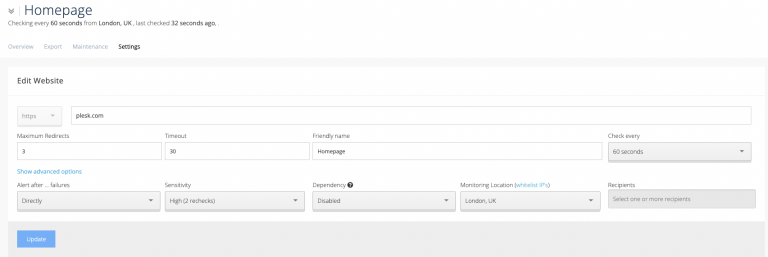Welcome to our new blog series in which we explore how we in the Plesk team are using our tools. Today we’re focusing on the site monitoring features of 360 Monitoring and how we set it up for our own website: plesk.com. Let’s go!
Which websites are we monitoring?
As our website plesk.com does not consist of a single page, we’re monitoring the website from multiple angles. Currently, we’re checking the following pages every 60 seconds:
- The Plesk Homepage
- Our Imprint
- Our Legal Pages & Privacy
- Policy
- Plesk Blog
- Plesk 360
- Our Support System
We use a caching mechanism to speed up our site, and it’s important that we’re also monitoring subpages of plesk.com as well to make sure that our legal pages and our 24/7 support are always reachable.
What settings are we using?
There are many settings available on the 360 Monitoring platform, and you can display the data spread across multiple dashboards as per your preferences. Before setting up your dashboards, however, you have to put settings in place so the system knows exactly how you want to monitor your page.
For this purpose, let’s first take a look at the settings we use for our main monitor on plesk.com:

Basic settings as demonstrated above: HTTPs, 3 Redirects, 30 seconds timeout but with high sensitivity which means the website is only checked 2-3 times before the system acknowledges the downtime. As location, we’ve chosen London, UK as the primary location but added 10 additional locations from around the world.
When it comes to subpages like the Plesk blog or our imprint, we’ve modified the default settings by only adding the dependency to the homepage. This streamlines notifications as it allows us to only get notified if the subpage itself is not reachable but the homepage is.
These settings ensure regular and thorough checks that funnel data to your dashboards and notification center.
The Plesk Status Page
Displayed proudly on big monitors in one of our Plesk offices, our team is using the Status Page option available from 360 Monitoring to always make sure to we have everything in sight easily and quickly if there is an issue.
All 360 Monitoring accounts can automatically access a public Status Page including the most important, up-to-date information on your site(s). Downtime can become a thing of the past!

Our alert settings
While downtime is rare, we’re prepared for anything, and our alerting options are based on multiple levels to make sure that we’re not waking everyone in the middle of the night if something is going down.
First of all, we set up multiple contacts to be notified in various scenarios. Keeping it simple, we went ahead and named them after the main recipient. The default notification channel of choice for us is to use Email and Slack but for urgent issues, we’ve also set up SMS and Discord notifications.

We trust our Plesk products, and we ensure the quality of each and every release by using the tools for ourselves. 360 Monitoring is a relatively new addition to the Plesk arsenal, and we are proud to say that it meets our standards in terms of UX and usability, as well as technology and innovation. We recommend this tool to our clients of all sizes!

